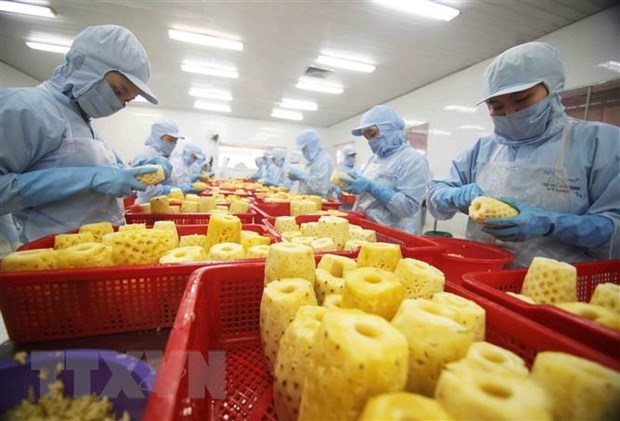 Processing canned pineapple at the factory of An Giang Agriculture and Foods Import Export Joint Stock Company. (Photo: VNA)
Processing canned pineapple at the factory of An Giang Agriculture and Foods Import Export Joint Stock Company. (Photo: VNA)However, it also means that six other businesses have not gained any benefit,direct or indirect, from the pact, which came into effect more than two yearsago.
Furthermore, despite an increase in Vietnam’s export value to the EU, the market’sshare in Vietnam’s total export has gradually shrank, from 19-20% ten years agoto less than 12% in 2021.
The growth rate of exportsto EU has always been lower than the average growth of Vietnam’s exports.
The issue was the focus of attention at the conference in Hanoi on November 18.
Ngo Chung Khanh, Deputy Director of the MultilateralTrade Policy Department under the Ministry of Industry and Trade (MoIT), saidthere are few Vietnamese brands able to make inroad into the EU market.
He noted that the share of many strategic exports of Vietnam in the EU market remainssmall, for example 2-3% for fruit and vegetables, over 4% for aquatic productsand textile-garment.
Khanh again stressed theneed to further popularise the EVFTA among Vietnamese businesses.
According to him, the MoIT is working with localities nationwide to pinpointthe strategic exports of each locality and build plans to support the export ofthose products to the EU.
The ministry expects tocoordinate closely with other ministries, sectors, local administrations, tradeassociations, and businesses to exploit to the fullest the benefits of theEVFTA, Khanh said.
The EU isthe third largest export market of Vietnam, with bilateral trade constantlygrowing even during the COVID-19 pandemic. The value of Vietnam’s export to EUin the period from August 2020 to July 2022 totalled 83.4 billion USD, averaging41.7 billion USD a year, up 24% from the average yearly growth in the 2016-2019period.
However, Vietnamese goods still account for less than 2% of the EU market./.



























